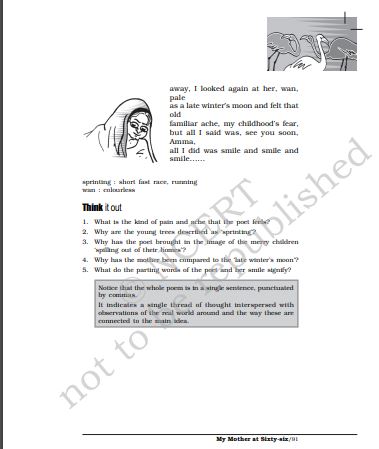‘NCERT Solutions for Class 12 English Flamingo Poetry 1 My Mother At Sixty Six‘ PDF Quick download link is given at the bottom of this article. You can see the PDF demo, size of the PDF, page numbers, and direct download Free PDF of ‘Ncert Class 12 English Flamingo Chapter 1 Exercise Solution’ using the download button.
My Mother At Sixty Six NCERT Textbook With Solutions Book PDF Free Download

Chapter 1: My Mother At Sixty Six
Kamala Das (1934) was born in Malabar, Kerala. She is recognised as one of India’s foremost poets.
Her works are known for their originality, versatility and the indigenous flavour of the soil. Kamala Das has published many novels and short stories in English and Malayalam under the name ‘Madhavikutty’.
Some of her works in English include the novel Alphabet of Lust (1977), a collection of short stories Padmavati the Harlot and Other Stories (1992), in addition to five books of poetry.
She is a sensitive writer who captures the complex subtleties of human relationships in lyrical idiom, My Mother at Sixty-six is an example.
Driving from my parent’s home to Cochin last Friday morning, I saw my mother, beside me,
doze, open mouthed, her face ashen like that of a corpse and realised with pain that she was as old as she looked but soon put that thought away, and looked out at Young Trees sprinting, the merry children spilling out of their homes, but after the airport’s security check, standing a few yards
away, I looked again at her, wan, pale as a late winter’s moon and felt that old familiar ache, my childhood’s fear, but all I said was, see you soon, Amma, all I did was smile and smile and
smile……
| Author | NCERT |
| Language | English |
| No. of Pages | 3 |
| PDF Size | 0.2 MB |
| Category | English |
| Source/Credits | ncert.nic.in |
NCERT Solutions Class 12 English Chapter 1 My Mother At Sixty Six
1. What is the kind of pain and ache that the poet feels?
Answer:
When the poet sees the corpse-like and pale face of her mother, her ache or the old familiar pain returns. Perhaps this fear was entertained by her since her childhood. Ageing is a process which occurs naturally. Ageing and time spare none. Ageing and time have not spared the mother of the poet and may not spare her as well. By ageing, death and separation becomes inevitable.
2. Why are the young trees described as ‘sprinting’?
Answer:
While driving to the Cochin airport, she observes outside the young trees which seemed to be walking across them. They seem to be sprinting or running fast with the speed of the car. The poet provides a contrast – the ‘sprinting’ young trees and her ‘dozing’ old mother.
3. Why has the poet brought in the image of the merry children ‘spilling out of their homes’?
Answer:
To present a contrast, the poet brought in the image of the merry children ‘spilling out of their homes’. The merry children who are coming out from their houses in huge numbers explain the spontaneous overflow and happiness of life.
It is different from the old mother ‘dozing’, whose ‘ashen’ face looks pale and lifeless, similar to a corpse. The description of the poet’s mother highly indicates passivity, decay and ageing in the poem. The contrast between these two images strengthens the effect of the poem.
4. Why has the mother been compared to the ‘late winter’s moon’?
Answer:
The mother of the poet is sixty-six years old. Her ‘ashen’ face which is shrunken is similar to that of a corpse. She has lost the strength of youth and her shine.
The late moon in the winter looks obscure and hazy. It also lacks strength and shine. This comparison is appropriate and quite natural. The simile which is used here is effective and apt.
5. What do the parting words of the poet and her smile signify?
Answer:
The parting words of the poet such as her smiles and assurance present a sharp contrast to the fear of childhood or the old familiar ache. Her smiles and words are a conscious attempt to hide her feelings.
The parting words – “See you soon, Amma” provides an assurance to the old woman whose ‘ashen face’ is similar to a corpse. In the same way, her continuous smile is an attempt to overcome the fear and ache which is present in her heart.
NCERT Class 12 English Textbook Chapter 1 My Mother At Sixty Six With Answer PDF Free Download
